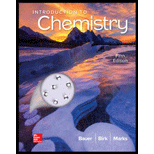
Concept explainers
(a)
Interpretation:
The structure that corresponds to tripeptide
(a)
Explanation of Solution
The simplest amino acid is alanine after glycine because the side chain in alanine is the methyl group
In the structure A, the first amino acid has the side chain
(b)
Interpretation:
The other tripeptides in the given structures are to be identified.
(b)
Explanation of Solution
In the structure B, the first amino acid has methyl group
(c)
Interpretation:
The other tripeptides in the given structures are to be identified.
(c)
Explanation of Solution
In the structure C, the first amino acid has hydrogen atom and it is not replaced by any substituent. So, the first amino acid is glycine
(d)
Interpretation:
The other tripeptides in the given structures are to be identified.
(d)
Explanation of Solution
In the structure D, the first amino acid has a side chain
(e)
Interpretation:
The other tripeptides in the given structures are to be identified.
(e)
Explanation of Solution
In the structure E, first amino acid has isobutyl group
Want to see more full solutions like this?
Chapter 17 Solutions
INTRODUCTION TO CHEMISTRY(LL)-W/CONNECT
 World of Chemistry, 3rd editionChemistryISBN:9781133109655Author:Steven S. Zumdahl, Susan L. Zumdahl, Donald J. DeCostePublisher:Brooks / Cole / Cengage Learning
World of Chemistry, 3rd editionChemistryISBN:9781133109655Author:Steven S. Zumdahl, Susan L. Zumdahl, Donald J. DeCostePublisher:Brooks / Cole / Cengage Learning Chemistry for Today: General, Organic, and Bioche...ChemistryISBN:9781305960060Author:Spencer L. Seager, Michael R. Slabaugh, Maren S. HansenPublisher:Cengage LearningChemistry: Matter and ChangeChemistryISBN:9780078746376Author:Dinah Zike, Laurel Dingrando, Nicholas Hainen, Cheryl WistromPublisher:Glencoe/McGraw-Hill School Pub Co
Chemistry for Today: General, Organic, and Bioche...ChemistryISBN:9781305960060Author:Spencer L. Seager, Michael R. Slabaugh, Maren S. HansenPublisher:Cengage LearningChemistry: Matter and ChangeChemistryISBN:9780078746376Author:Dinah Zike, Laurel Dingrando, Nicholas Hainen, Cheryl WistromPublisher:Glencoe/McGraw-Hill School Pub Co World of ChemistryChemistryISBN:9780618562763Author:Steven S. ZumdahlPublisher:Houghton Mifflin College Div
World of ChemistryChemistryISBN:9780618562763Author:Steven S. ZumdahlPublisher:Houghton Mifflin College Div Introductory Chemistry: An Active Learning Approa...ChemistryISBN:9781305079250Author:Mark S. Cracolice, Ed PetersPublisher:Cengage Learning
Introductory Chemistry: An Active Learning Approa...ChemistryISBN:9781305079250Author:Mark S. Cracolice, Ed PetersPublisher:Cengage Learning Chemistry: Principles and PracticeChemistryISBN:9780534420123Author:Daniel L. Reger, Scott R. Goode, David W. Ball, Edward MercerPublisher:Cengage Learning
Chemistry: Principles and PracticeChemistryISBN:9780534420123Author:Daniel L. Reger, Scott R. Goode, David W. Ball, Edward MercerPublisher:Cengage Learning





